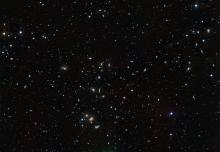Listen to today's episode of StarDate on the web the same day it airs in high-quality streaming audio without any extra ads or announcements. Choose a $8 one-month pass, or listen every day for a year for just $30.
You are here
More Hercules
The senior citizens of the Milky Way galaxy are its globular clusters. Most of these giant balls of stars are more than 10 billion years old. And one of the oldest of them all measures out at about 14 billion years — as old as the universe.
That cluster is known as M92. It’s in Hercules, which is in the east and northeast as night falls. It’s an easy target for binoculars, to the left of the Keystone, a lopsided square of stars that outlines the strongman’s body.
M92 isn’t as prominent as another globular cluster in Hercules, M13. Even so, it’s one of the brightest globulars in the night sky. It spans several dozen light-years, and it contains several hundred thousand stars.
Astronomers have measured its age by measuring the composition of those stars. They’re made almost entirely of hydrogen and helium, the simplest chemical elements. They have only a tiny smattering of heavier elements.
Hydrogen and helium were forged in the Big Bang. Almost all the other elements were made by stars. When stars die, they expel some of their material into space, where it can be incorporated into new stars. So each generation of stars has a higher proportion of the heavier elements.
That means that stars with almost none of these elements were born when the universe was young. In the case of M92, they were born not long after the universe itself was — making the cluster one of the oldest members of the Milky Way galaxy.
Script by Damond Benningfield



